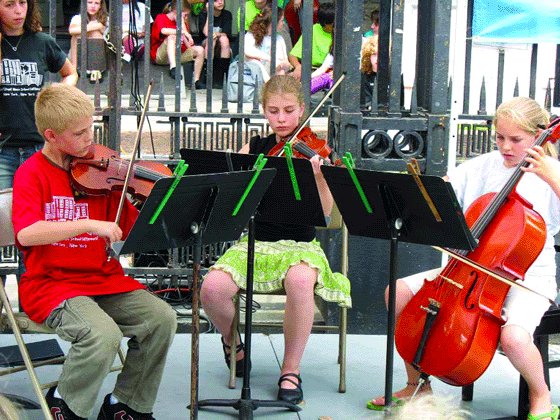By Mary Reinholz
The sun-baked streets of the East Village can yield visions that turn out to be real, although seemingly out of place — like kids as young as 7 and 8 playing chamber music with violin, cello, flute, harp and piano in a neighborhood where heavy metal rock seems to rule.
Yet there they were, 46 youngsters performing in the classical mode earlier this summer under a tent in Abe Lebewohl Park in front of St. Mark’s Church in-the-Bowery, looking like characters plucked from Norman Rockwell’s Americana: tousle-haired boys with freckles on their faces and girls in Mary Jane shoes and pastel dresses making serenely beautiful music for an appreciative crowd of about 150 seated on folding metal chairs.
They were students from the venerable Third Street Music School Settlement, coming together in trios and quartets to deliver the stately cadences of Mozart and Haydn, even though the feet of at least one young musician pounding the keyboard from an adult-sized piano bench barely touched the ground.
“People generally think classical is for musically mature musicians,” said Mary Lou Francis, director of programs at the Third Street Music School. “But we believe the sooner you get youngsters playing it, the sooner they will develop confidence and build cooperative attitudes. When you’re playing with other people, you have to listen, you have to be cooperative.”
Church bells overhead tolled during a brief intermission between the sets played by students grouped together by age and instrument, the oldest being no more than 16 or 17. All had completed an intensive eight-day workshop of the Third Street Music School’s chamber music and ensemble program, open to any youngster who can read music, count and pass muster in auditions with the program’s director, Mary Jo Pagano.
“Mary Jo matches them in age and musical maturity,” said Francis. “You can’t put a 15-year-old with an 8-year-old or 10-year-old — and you can’t take 30 violins and 10 cellists. There has to be a balance. It’s a skill to match children up and take a piece without it being too difficult. No one is allowed not to be successful,” she added, noting that tuition for the chamber music workshop was $600 and there is tuition assistance for any family “who can’t afford it. That’s typical of any of our programs,” she noted.
The Music in Abe Lebewohl Park that day was produced and presented by the school and the Tenth & Stuyvesant Sts. Block Association together with St. Mark’s Church. It was part of a free lunchtime series that began June 1 with New Orleans Jazz and concluded July 20 with a performance by Paprica, an all-female acid rock band. Con Edison was the sponsor for a sixth summer. Support also comes from nearby Veselka restaurant, the New York University Community Fund, New York State Council on the Arts and Friends of Abe Lebewohl Park.
People behind the scenes for the chamber music included teenage teaching assistants, all of them Third Street graduates, like Mike Trout, 19, who plays cello and attends Queens College.
“I’ve been going to this place since I was born,” he said of the 112-year-old school, which also offers instruction in other music, dance and the visual arts to some 3,500 children and teenagers each year, some at community centers across the Lower East Side. Funding comes from groups like the Carnegie Foundation, corporations and individual contributions, Francis said.
Vic Pauly, 18, who is headed for Rutgers, is another assistant faculty member and graduate of Third Street, who said he often felt while growing up “like I was living in the school.” He believes the youngsters who come for instruction in classical music are special kids, but adds: “I think it comes down to the parents having to play a key role in getting kids to understand classical music. There’s something special about classical music because it has such a history to it, but the good thing about Third Street is that it’s a very casual school. It teaches kids how to play music well but to have fun doing it, so they don’t get stressed out.”
The settlement house, located at 235 E. 11th St., is touted as the nation’s oldest community music school.
Speaking after the outdoor concert earlier this summer, Kyle McCormick, 11, who has been studying music at the school on Saturdays for close to four years, commuting from his Harlem home, said he likes chamber music “because I like the idea of how music blends together when you’re in a small group. It’s like playing with four soloists and you make them into one group.” McCormick said his parents would be present when he played a Slavonic dance piece by Dvorak with two other students in the school’s auditorium that evening.
“It’s challenging,” he said with an earnest smile.
Matthew Battifarano, 15, who plays the clarinet, said he had been in a band at Stuyvesant High School before deciding to apply for after-school classes in chamber music at the Third Street School.
“This is a different kind of music,” he said. “It takes you to a different level.”
































